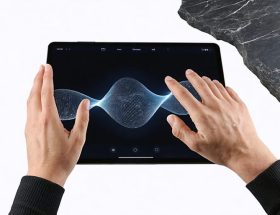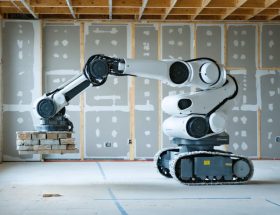In the rapidly evolving landscape of digital construction and design, 3D digital twins are revolutionizing how we interact with natural stone projects. These exact virtual replicas capture every detail, texture, and characteristic of physical stone installations, enabling unprecedented levels of analysis, planning, and optimization.
Imagine walking through a detailed virtual representation of your stone project before a single slab is cut. From quarry to final installation, 3D digital twins are transforming how architects, designers, and stone professionals visualize, plan, and execute their projects. This technology creates a dynamic, data-rich environment where every aspect of a stone installation can be tested, modified, and perfected in real-time.
By bridging the gap between physical and digital worlds, 3D digital twins offer more than just visualization – they provide a powerful platform for collaboration, maintenance prediction, and project optimization. For natural stone applications, this means reduced waste, improved accuracy, and enhanced project outcomes that were previously impossible to achieve through traditional methods.
As we stand at the intersection of traditional craftsmanship and cutting-edge technology, 3D digital twins are not just tools – they’re game-changers that are reshaping the future of natural stone design and implementation.
How 3D Digital Twins Work in Stone Projects
Scanning and Data Collection
Creating an accurate digital twin begins with comprehensive scanning and data collection of the physical stone material. Advanced 3D laser scanners capture precise measurements and surface characteristics, while high-resolution photogrammetry documents color variations and texture details. These technologies work together to create point clouds containing millions of data points that accurately represent the stone’s physical properties.
Modern scanning equipment can detect subtle variations in material composition, identifying veining patterns, inclusions, and potential structural weaknesses. This detailed information feeds into AI-powered stone mapping technology that processes the raw data into detailed digital models.
The scanning process typically involves multiple passes from different angles to ensure complete coverage and eliminate shadows or blind spots. Specialized software then combines these scans into a single, coherent 3D model. Environmental factors such as lighting conditions and surface reflectivity are carefully controlled during scanning to ensure optimal data quality. This methodical approach results in highly accurate digital representations that serve as the foundation for further analysis and design work.
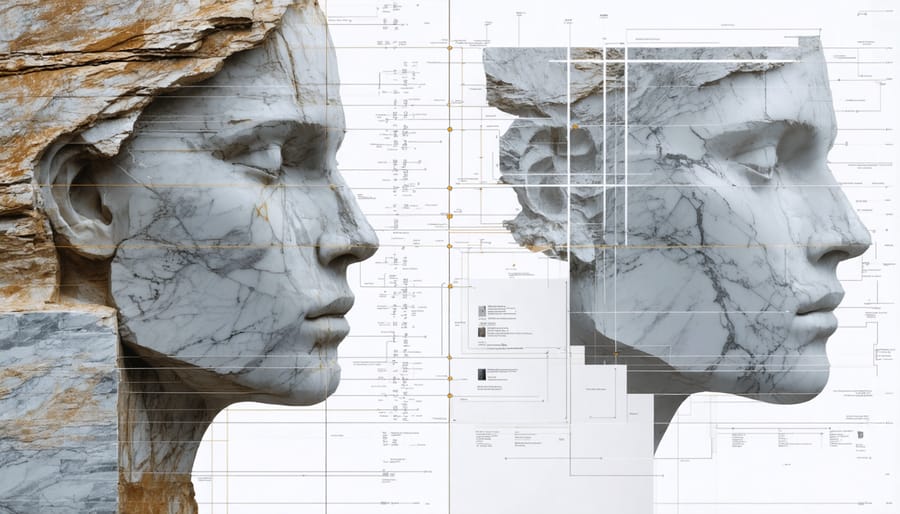
Real-time Monitoring and Updates
Digital twins maintain a continuous connection with their physical counterparts through an array of sophisticated sensors and monitoring systems. These sensors track vital stone properties such as moisture content, structural integrity, temperature variations, and wear patterns in real-time. The data streams directly into the digital model, ensuring that the virtual representation always mirrors the current state of the physical stone installation.
Advanced IoT devices and monitoring equipment capture subtle changes in the stone’s condition, from microscopic cracks to shifts in environmental conditions. This immediate feedback allows stakeholders to identify potential issues before they escalate into serious problems. For instance, if moisture levels exceed acceptable thresholds, the system automatically alerts maintenance teams to investigate and address the situation.
The digital twin also maintains historical data, creating a comprehensive timeline of the stone’s performance and maintenance history. This temporal tracking enables predictive analytics, helping professionals anticipate future maintenance needs and optimize care schedules. Regular updates to the model ensure that all stakeholders have access to the most current information, facilitating informed decision-making and proactive stone management.
Key Benefits for Stone Industry Professionals
Quality Control and Assessment
Digital twins revolutionize quality control in stone selection by creating precise virtual replicas that enable thorough inspection and verification before physical handling. These detailed 3D models capture surface characteristics, veining patterns, and potential defects with millimeter accuracy, allowing professionals to assess material quality remotely.
The technology employs advanced scanning and imaging systems to analyze stone blocks and slabs, identifying imperfections, structural weaknesses, and color variations that might not be immediately visible to the naked eye. This comprehensive assessment helps prevent costly mistakes and ensures consistency in large-scale projects.
Quality verification becomes more systematic and reliable through automated analysis tools that measure key parameters like density, porosity, and surface finish. The digital twin can simulate how the stone will appear under different lighting conditions and viewing angles, providing accurate predictions of the final installed appearance.
For fabricators and installers, these virtual models serve as reference points throughout the production process, ensuring that each piece meets specifications and quality standards. The technology also maintains detailed documentation of quality assessments, creating a traceable record for certification and warranty purposes.
Project Planning and Visualization
Digital twins revolutionize project planning by creating precise virtual replicas of stone installations before physical construction begins. This technology enables architects and designers to visualize complex stone patterns, evaluate different material options, and identify potential challenges early in the project lifecycle. When combined with augmented reality visualization tools, digital twins offer unprecedented accuracy in spatial planning and design verification.
Project stakeholders can explore virtual walkthrough experiences, examining every detail from various angles and lighting conditions. This capability proves invaluable during client presentations, allowing immediate visualization of design alternatives and material selections. Contractors can utilize these models to calculate precise material quantities, reducing waste and optimizing cost estimates.
The technology also facilitates better collaboration among team members, as everyone works from the same detailed 3D model. Changes can be implemented and evaluated in real-time, ensuring all stakeholders remain aligned throughout the project. This streamlined approach to project planning significantly reduces the risk of costly modifications during construction and helps maintain project timelines by identifying potential issues before they become problems on-site.
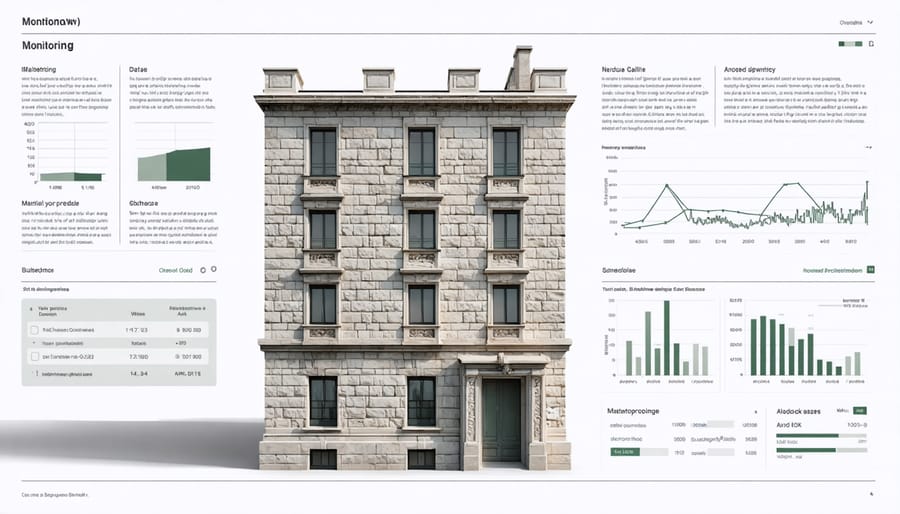
Maintenance and Lifecycle Management
Digital twins revolutionize stone maintenance by providing a comprehensive approach to lifecycle management. Through continuous monitoring and data collection, these virtual replicas enable facility managers and maintenance teams to track the condition of stone installations in real-time. The integration with predictive maintenance systems allows early detection of potential issues, from moisture infiltration to structural stress points.
This proactive approach significantly extends the lifespan of stone installations while reducing maintenance costs. By analyzing historical data and environmental factors, digital twins can forecast maintenance needs and optimize scheduling of interventions. Facility managers can visualize aging patterns, track wear and tear, and implement preventive measures before visible damage occurs.
The technology also maintains a detailed record of all maintenance activities, material specifications, and environmental conditions affecting the stone. This comprehensive documentation proves invaluable for long-term preservation strategies and future renovations. Building owners can make informed decisions about maintenance investments based on actual performance data rather than assumptions, ensuring the sustainable management of stone assets throughout their lifecycle.
Practical Applications
Quarry Operations
Digital twin technology has revolutionized quarry operations by creating precise virtual replicas of stone extraction sites. These digital models combine real-time data from sensors, drones, and 3D scanning to provide accurate representations of quarry conditions and inventory levels.
Quarry operators can monitor extraction progress, track stone block locations, and assess material quality through the digital interface. The technology enables better planning of cutting sequences, optimizing equipment placement, and reducing waste during extraction. Real-time monitoring helps identify potential safety hazards and ensures compliance with quarrying regulations.
For inventory management, digital twins maintain detailed records of available blocks, including dimensions, quality grades, and veining patterns. This information helps suppliers match specific stones to client requirements more efficiently. The system can also predict future yield based on geological data and extraction patterns, allowing for more accurate production planning.
The integration of digital twins in quarry operations has led to significant improvements in operational efficiency, with some operations reporting up to 20% reduction in waste material and 30% improvement in productivity. These virtual models also facilitate better communication between quarry sites and processing facilities, ensuring smoother supply chain operations.
Construction Projects
In construction projects, 3D digital twins are revolutionizing how natural stone installations are planned, executed, and maintained. By creating precise virtual replicas of buildings, architects and contractors can visualize and analyze stone applications before physical implementation begins. This technology seamlessly integrates with modern parametric design in stone architecture, enabling real-time adjustments and optimizations.
During renovation projects, digital twins allow teams to assess existing structures and plan modifications without disrupting ongoing operations. Contractors can identify potential challenges, such as structural limitations or material compatibility issues, before stone installation begins. This proactive approach significantly reduces costly mistakes and project delays.
The technology also facilitates better collaboration between stakeholders. Project managers can share detailed 3D models with stone fabricators, ensuring precise measurements and specifications are met. During construction, real-time monitoring through IoT sensors connected to the digital twin helps track installation progress, material performance, and environmental conditions, ensuring optimal results in stone applications.
Historic Preservation
3D digital twin technology has revolutionized historic preservation efforts in stone structures by creating precise virtual replicas of heritage buildings and monuments. These detailed digital models serve as invaluable resources for restoration projects, allowing conservators to analyze structural conditions, document deterioration, and plan interventions with unprecedented accuracy.
Through high-resolution scanning and photogrammetry, every surface detail, including weathering patterns, structural cracks, and ornamental features, can be captured and preserved digitally. This documentation becomes crucial when original architectural elements need repair or replacement, ensuring authenticity in restoration work.
Notable examples include the digital preservation of medieval cathedrals and ancient ruins, where digital twins have enabled conservators to monitor structural changes over time and simulate the effects of proposed conservation treatments before implementation. The technology also provides a permanent digital record of historic structures, protecting their cultural legacy for future generations.
In cases of damage or disaster, these digital models can guide precise reconstruction efforts, ensuring restored elements match the original architecture exactly. This combination of preservation and practical application makes digital twin technology an essential tool in modern heritage conservation.
Implementation Considerations
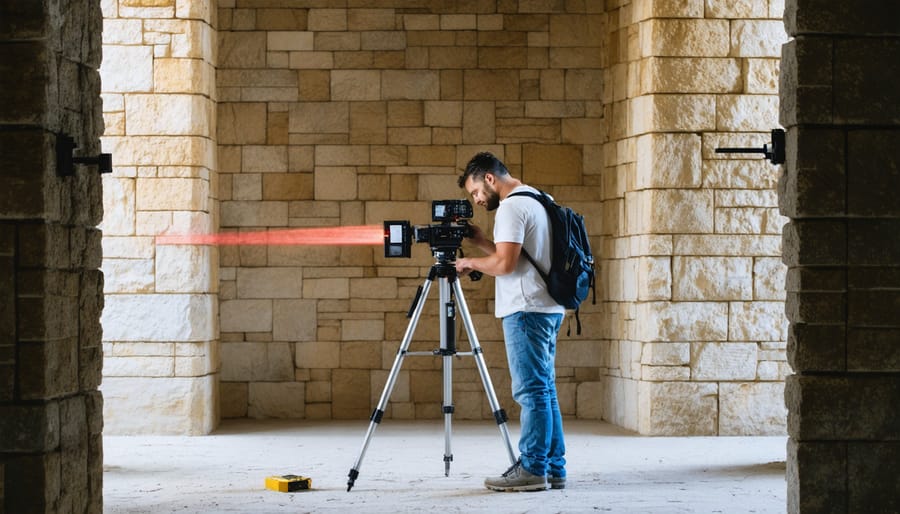
Technology Requirements
Creating an accurate 3D digital twin requires a comprehensive set of hardware and software tools. The foundation starts with high-precision 3D scanning equipment, such as laser scanners or photogrammetry devices, to capture detailed geometric data of stone surfaces and structures. These scanners must offer sub-millimeter accuracy to ensure precise representation of natural stone textures and patterns.
For software requirements, a robust CAD (Computer-Aided Design) platform serves as the base for digital twin development. Industry-standard options include Autodesk Revit, Rhino, or similar BIM-compatible software. Additionally, specialized point cloud processing software is necessary to handle the large datasets generated during scanning.
Real-time data integration requires IoT sensors and connectivity solutions to monitor physical changes in stone structures. These sensors track parameters like temperature, moisture, and structural stress. A reliable cloud computing infrastructure is essential for storing and processing the substantial amount of data generated by these sensors.
Visualization tools and rendering software are crucial for creating photorealistic representations of stone surfaces. These should support material-specific properties like veining, finish types, and light interaction. For collaborative projects, a secure platform for data sharing and version control ensures all stakeholders can access and update the digital twin as needed.
The system should also include analytics software capable of processing historical data and predicting maintenance needs or potential issues in stone installations.
Best Practices and Tips
For successful implementation of a 3D digital twin in natural stone applications, start by ensuring accurate data collection through high-resolution scanning and detailed measurements of the physical stone elements. Regular updates to the digital model are crucial to maintain synchronization with the actual structure or material changes.
Establish clear communication protocols between all stakeholders involved in the digital twin project. This includes architects, stone fabricators, installers, and maintenance teams. Document all processes and create standardized procedures for data input and model updates.
Invest in reliable software platforms that offer compatibility with common file formats used in the stone industry. Choose solutions that provide real-time monitoring capabilities and can handle large datasets efficiently. Consider cloud-based systems for better accessibility and collaboration.
Implement robust security measures to protect sensitive project data and intellectual property. Regular backups and version control systems help maintain data integrity and allow for easy recovery if needed.
Train your team thoroughly on the digital twin platform and establish ongoing support systems. Create detailed documentation for troubleshooting common issues and maintain a knowledge base of best practices specific to your stone applications.
Start with smaller pilot projects before scaling to larger implementations. This allows for testing and refinement of processes while minimizing risks. Monitor system performance regularly and gather feedback from users to continuously improve the digital twin’s effectiveness.
The integration of 3D digital twin technology in natural stone applications represents a transformative shift in how we approach stone design, fabrication, and maintenance. As we’ve explored throughout this article, digital twins offer unprecedented capabilities for visualizing, planning, and optimizing stone projects while significantly reducing waste and errors. The technology continues to evolve rapidly, with emerging developments in AI and machine learning promising even more sophisticated applications.
Looking ahead, we can expect to see wider adoption of digital twins across the natural stone industry, from quarry operations to final installation. This technology will become increasingly accessible to smaller businesses, democratizing advanced stone project management and enabling more sustainable practices. The ability to create accurate virtual representations of stone materials and installations will continue to improve, leading to more efficient workflows and better outcomes for clients.
As sustainability becomes increasingly crucial, digital twins will play a vital role in optimizing material usage and reducing environmental impact. This technology isn’t just a trend – it’s becoming an essential tool for the future of natural stone applications, bridging the gap between traditional craftsmanship and modern innovation.


